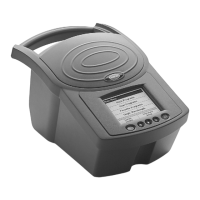Barium
Barium
Page 4 of 6
Barium_AVPP_Other_TUR_Eng_Ody.fm
Standard Solutions
Prepare a 90.0-mg/L barium standard solution as follows:
1. Pipet 9.00 mL of Barium Standard Solution, 1000-mg/L, into a 100-mL
volumetric flask.
2. Dilute to the mark with deionized water.
3. Prepare this solution daily. Perform the barium procedure as described above.
To adjust the calibration curve using the reading obtained with the 90.0-mg/L
standard solution:
1. Touch
Options on the current program menu. Touch Standard Adjust on the
Options menu.
2. Touch
On. Touch Adjust to accept the displayed concentration. If an alternate
concentration is used, touch the number in the box to enter the actual
concentration, then touch
OK. Touch Adjust.
See Section 3.2.4 Adjusting the Standard Curve on page 40 for more information.
Accuracy Check
Standard Additions Method (Sample Spike)
1. After reading test results, leave the unspiked sample in the instrument.
Verify that the units displayed are in mg/L.
2. Touch
Options. Touch Standard Additions. A summary of the standard
additions procedure will appear.
3. Touch
OK to accept the default values for standard concentration, sample
volume, and spike volumes. Touch
Edit to change these values. After values
are accepted, the unspiked sample reading will appear in the top row. See
Standard Additions in the instrument manual for more information.
4. Open a Barium Standard Solution, 1000-mg/L Ba.
5. Prepare a 0.1 mL sample spike by adding 0.1 mL of standard to the unspiked
sample. Touch the timer icon. After the timer beeps, read the result.
6. Prepare a 0.2 mL sample spike by adding 0.1 mL of standard to the 0.1 mL
sample spike. Touch the timer icon. After the timer beeps, read the result.
7. Prepare a 0.3 mL sample spike by adding 0.1 mL of standard to the 0.2 mL
sample spike. Touch the timer icon. After the timer beeps, read the result.
Each addition should reflect approximately 100% recovery.
Note: For AccuVac Ampuls, fill three mixing cylinders (Cat. No. 1896-41) with 50 mL of sample and
spike with 0.2 mL, 0.4 mL, and 0.6 mL of standard. Transfer 40 mL from each of the three
mixing cylinders to three 50-mL beakers. Analyze each standard addition sample as
described in the procedure above. Accept each standard additions reading by touching
Read. Each addition should reflect approximately 100% recovery.
8. After completing the sequence, touch Graph to view the best-fit line through
the standard additions data points, accounting for matrix interferences. Touch
View: Fit, then select Ideal Line and touch OK to view the relationship between
the sample spikes and the “Ideal Line” of 100% recovery.
See Section 3.2.2 Standard Additions on page 32 for more information.

